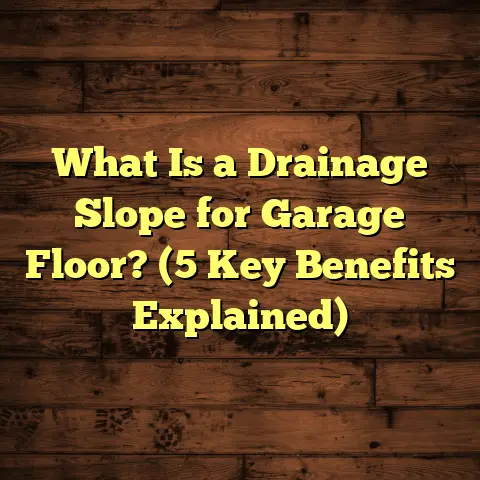What is Proper Drainage Pitch for Garage Floor? (5 Key Factors!)
I’ve been in the flooring and renovation business for quite a while now, and it’s funny how some of the most overlooked details can cause the biggest headaches down the line. Take garage floors, for example. I once worked on a client’s garage that was fine structurally but had serious water pooling problems. Every time it rained or when they washed their car, water would collect in spots, making it slippery and damaging the floor finish. It was frustrating for them and costly to fix.
That experience stuck with me because it showed me how critical proper drainage pitch is for garage floors. It’s one of those things that doesn’t get much attention until it becomes a problem. Over the years, I’ve helped many homeowners and contractors understand and apply the right slope to garage floors so water flows where it should — away from the house and into drains or off the property.
In this article, I’m going to share what I’ve learned about proper drainage pitch for garage floors. Not just the basics, but actionable insights, backed by data and real-world examples. If you’re planning a garage renovation or new build, this info can save you time, money, and a lot of frustration.
What is Proper Drainage Pitch for Garage Floors?
When I say “drainage pitch,” I’m talking about the intentional slope built into a floor so water naturally moves toward a specific location like a drain or exit point, instead of pooling anywhere. It’s all about gravity doing its job.
You might wonder how steep this slope should be — not too flat that water stands around, but not too steep that it becomes uncomfortable or even unsafe.
From my experience working with concrete specialists and home builders, the generally recommended drainage pitch for garage floors falls between:
- 1/8 inch per foot (around 1% slope)
- 1/4 inch per foot (around 2% slope)
That means for every foot of floor length, the surface drops by between 0.125 inches to 0.25 inches in elevation toward the drainage point.
Why these numbers? Well, less than 1/8 inch per foot usually isn’t enough to move water quickly — it tends to pool in low spots. More than 1/4 inch per foot can feel steep and affect comfort and usability inside the garage.
A garage floor with the right drainage pitch will:
- Prevent water pooling
- Reduce slip hazards
- Protect concrete from water damage
- Keep vehicles and stored items dry
I remember a project where a garage floor was almost flat except near the drain. Water didn’t flow well and pooled around the edges, causing mildew issues. After re-pitching the floor to about 1/4 inch per foot slope toward a trench drain, those problems disappeared.
Why Should You Care About Drainage Pitch?
Maybe you think your garage floor is “good enough” as it is. But here’s why paying attention to drainage pitch pays off:
- Avoid costly repairs: Standing water deteriorates concrete over time. It causes cracks, spalling, and damage that require expensive fixes.
- Prevent mold and mildew: Moisture encourages mold growth on walls or stored items.
- Improve safety: Water pooling makes floors slippery.
- Protect vehicles: Water can rust car undercarriages if it sits too long.
- Maintain aesthetics: Water stains and mineral deposits ruin your garage’s look.
I’ve seen garages where ignoring drainage led to ruined flooring coatings, damaged drywall along walls due to excess moisture, and unhappy homeowners having to redo floors entirely.
The 5 Key Factors That Affect Garage Floor Drainage Pitch
Getting the pitch right isn’t about just picking a number out of thin air. Several factors influence what slope works best for your specific garage.
1. Garage Size and Layout Shape
The size and shape of your garage are critical in determining how you design your drainage pitch.
For example:
- In a standard two-car garage (about 20 x 20 feet), slopes often direct water toward a single drain located near the center or back wall.
- For larger garages or those with irregular shapes (like L-shaped or tandem garages), you might need multiple drainage slopes or several drains.
- Smaller garages or single-car garages often slope directly toward the garage door.
I once worked on a large custom garage that was 30 feet deep with two doors at each end. We designed two separate slopes—one directing water toward the front door and another toward the back door—with a slight ridge in between to keep water flowing properly.
If you picture your garage floor as a landscape, your goal is to avoid “valleys” where water collects and instead create “hills” that guide water flow toward drains or exits.
2. Local Climate and Rainfall Patterns
Have you ever thought about how much rain your region gets? It turns out this matters quite a bit.
In areas with heavy rainfall, like Seattle or Atlanta, you want to lean toward a steeper pitch — closer to 1/4 inch per foot — so water moves quickly off your floor before it has time to puddle.
On the other hand, in drier climates like Phoenix or Las Vegas, where heavy rain is rare, a gentler slope of around 1/8 inch per foot usually works well.
According to NOAA rainfall data:
- Seattle averages about 37 inches of rain annually
- Phoenix averages less than 9 inches
If you live somewhere with heavy rain or snowmelt, don’t underestimate how important proper pitching is for your garage floor.
3. Garage Floor Material and Surface Texture
Most garages have concrete floors — but not all concrete floors are created equal.
Concrete’s porosity can vary depending on mix design and finishing techniques. Also, many homeowners add surface coatings like epoxy or textured finishes for durability and slip resistance.
Here’s what I’ve learned:
- Smooth concrete lets water flow easily but can be slippery.
- Textured or epoxy-coated surfaces slow water down slightly but improve safety.
- If you use coatings that slow water flow, you may need to increase slope slightly to compensate.
Once I helped a client whose epoxy-coated floor still had puddles despite having some slope. We ended up adjusting the pitch closer to 1/4 inch per foot, which made all the difference.
4. Location of Drains and Water Exit Points
Do you have drains installed? Or does water just flow out under the garage door?
Drain placement influences how you design slopes:
- If there’s a trench drain along one wall or a floor drain in the middle, floors should gently slope directly toward those points.
- If no drains exist, slopes usually lead toward garage doors or natural terrain slopes outside.
- Sometimes multiple drains are necessary for larger garages or unusual layouts.
In my experience, placing trench drains near garage entrances works best because they catch water before it reaches your driveway or foundation.
If you have no drains, make sure your garage floor slopes enough toward the door so water doesn’t pool inside during rainstorms or washing.
5. Local Building Codes and Industry Standards
Before starting any project involving drainage slopes, always check local building codes. They often specify minimum slope requirements or drainage system types.
For example:
- The International Residential Code (IRC) recommends at least 1/4 inch per foot slope for exterior concrete slabs exposed to weather.
- Some cities require specific drain installations for garages over certain sizes.
I once had a client whose garage floor didn’t meet local slope requirements. After failing inspection, we had to redo part of the slab. It was an expensive lesson about following rules upfront instead of cutting corners.
How to Calculate and Measure Your Garage Floor Pitch
One of the questions I get asked a lot is: How do I check if my garage floor has the right slope? Or how do I calculate what pitch to build?
Here’s what I do step-by-step:
Tools You’ll Need:
- Long straight edge (like a 6-foot level board)
- Carpenter’s level or laser level
- Tape measure
- Marker or chalk
Step 1: Find Your Reference Point
Choose the highest point on your floor as your reference spot — usually farthest from your drain or exit point.
Step 2: Place The Straight Edge
Place your straight edge on this high point extending toward where water should flow (drain or door).
Step 3: Measure The Gap Under The Board
Put your level on top of the straight edge to check if it’s level side-to-side. Then measure the vertical gap between the floor and bottom of the straight edge at the lower end.
Step 4: Calculate The Pitch
Divide that vertical drop by the length between points.
For example:
If your straight edge is 6 feet long and there is a 1-inch drop from one end to another,
Pitch = 1 inch / 72 inches = 0.0139 = approx 1.39%
This means your pitch is about 1/8 inch per foot, which is within range for good drainage.
Real-Life Stories About Getting The Pitch Right (Or Wrong)
Let me share some examples from my work that highlight why this matters so much.
Story #1: The Garage With Standing Water
A client called me after they noticed puddles forming near their garage door every time it rained. When I visited, I found their new concrete slab was almost flat except near one corner where it dipped slightly.
Water was getting trapped in low spots causing slippery conditions and damage to stored items on pallets.
We ended up grinding down high spots in other areas and adding an overlay with correct slope at around 1/4 inch per foot toward a newly installed trench drain along one side wall.
After that fix? No more puddles!
Story #2: Custom Home Garage Designed Right From The Start
In another project during new construction of a custom home, we made sure drainage was planned before pouring concrete.
The garage opened onto a sloped driveway with no drains inside. We designed a continuous slope of 1/8 inch per foot directly toward the door opening so rainwater would naturally flow outside without pooling inside.
This saved thousands by avoiding drain installation costs while keeping the space dry and functional year-round.
Story #3: Epoxy Floor Coating & Drainage Adjustment
A homeowner with an epoxy-coated floor complained about slow draining after washing their car. We measured their slope and found it was on the low end—less than 1/8 inch per foot in some spots—and some areas were flat.
We adjusted the slope by grinding certain sections during floor preparation then reapplying epoxy coatings with proper pitch at 1/4 inch per foot slope.
Water now flows efficiently off their floor without pooling or slipping issues.
The Science Behind Water Flow on Concrete Surfaces
You might be curious why even small differences in slope matter so much for drainage.
Water moves due to gravity but also surface tension and friction between water molecules and concrete surfaces.
On very flat surfaces (<1/8 inch per foot):
- Water surface tension resists flow
- Minor dips cause pooling
- Evaporation takes longer
- Dirt accumulates in puddles
Increasing slope just slightly increases gravitational force overcoming surface tension and friction forces so water flows faster off floors before pooling occurs.
This explains why minor adjustments can dramatically improve drainage performance even if you can’t see major differences visually.
Common Mistakes I See With Garage Floor Drainage Pitch
Over my years working on garages, I’ve noticed some repeated errors homeowners or contractors make:
Neglecting To Check Existing Slope Before Pouring Concrete
Some think “flat” is fine without testing how water flows after finishing walls or cabinets are installed. This leads to pricey fixes later.
Installing Drains Without Proper Slope Toward Them
Water won’t flow uphill! No matter how good your drain is if the floor doesn’t pitch correctly toward it, you get puddles around drains instead of into them.
Using Too Steep A Slope Inside Garages
Slopes steeper than 1/4 inch per foot can create tripping hazards or make parking cars awkward due to uneven surfaces under tires.
Not Considering Local Climate Effects
I once had a client in Florida who used pitches suited for dry climates — resulting in poor drainage during heavy tropical rains because slopes weren’t steep enough.
How To Fix Drainage Problems Without Completely Replacing Your Garage Floor
If you already have drainage issues but don’t want to rip out your entire floor, there are ways to improve things:
Grinding High Spots & Resurfacing With Overlay Concrete
This is what I often recommend when minor pitch corrections are needed. Grinding removes bumps creating low points; overlays add thin layers with proper slope toward drains.
Adding Trench Drains or Channel Drains
Installing additional drains combined with slight floor adjustments helps catch and redirect water more effectively.
Using Epoxy Coatings With Anti-Slip Additives
These coatings protect concrete from moisture damage while improving traction reducing slip risks from standing moisture spots.
Budgeting Your Garage Floor Project: How Tools Like FloorTally Help Me Stay On Track
Estimating costs accurately is tough because prices vary by location, materials, labor rates, and project complexity.
I use tools like FloorTally when planning projects involving concrete repairs or new pours with drainage adjustments. It lets me enter precise parameters like:
- Concrete type (standard mix vs high-strength)
- Labor hours based on area size
- Local material costs
- Waste factors so I don’t overbuy materials
This helps me generate reliable cost estimates quickly without chasing multiple quotes constantly.
It’s not just about pricing—it makes it easier to explain budgets transparently to clients so there are no surprises mid-project. Plus, I can compare different scenarios (adding drains vs simple overlays) easily to find best value solutions.
Materials and Methods for Building Proper Drainage Pitch Garage Floors
I want to give you some practical ideas about materials and techniques professionals use to create proper drainage pitches:
Concrete Mix Design
For garage floors requiring good drainage:
- Use mixes with appropriate slump (flow) characteristics so surface finishes are smooth yet strong.
- Reinforce with wire mesh or rebar to prevent cracking from temperature changes or settling.
Finishing Techniques
Finishing impacts drainage performance too:
- Use power troweling for smooth surfaces.
- Apply broom finishes in outdoor areas needing slip resistance.
Drain Installation Basics
Drain types include:
- Trench drains: long narrow channels usually installed near doors or walls.
- Floor drains: typically round drains placed mid-floor.
Ensure drains connect properly to stormwater systems or soakaway pits to avoid backflow problems downstream.
What About DIY? Can You Fix Or Install Proper Drainage Pitch Yourself?
If you ask me honestly…
DIYing concrete work including drainage pitches isn’t easy unless you have experience with leveling tools, pouring techniques, and finishing skills.
Mistakes are costly because fixing improper slopes after curing concrete means expensive grinding or total replacement in worst cases.
That said:
- Small fixes like cleaning existing drains or sealing floors can be DIY-friendly.
- Measuring slopes using levels is doable if you have patience.
But major adjustments? I usually recommend hiring professionals who know these systems inside out—trust me on this one!
Final Thoughts on Getting Your Garage Floor Drainage Right
Water pooling inside garages might seem like a small nuisance now but left unchecked it causes big problems down the road—from structural damage to safety issues and expensive repairs.
Getting your drainage pitch right means thinking through:
- Your garage size & layout
- Local climate & rainfall
- Floor materials & coatings
- Drain locations
- Building codes & standards
Slopes between 1/8 inch to 1/4 inch per foot usually provide effective drainage without creating hazards inside garages.
If you’re planning renovations involving new concrete pours or overlays—take time measuring existing slopes carefully beforehand. If possible design slope before pouring concrete incorporating drains strategically for best results.
And if budgeting stresses you out like it does me sometimes—tools like FloorTally help me break down costs clearly so I can plan smartly without surprises later on.
Got questions about measuring slopes? Need tips on choosing materials? Just ask—I’m happy to share what I’ve learned after years working hands-on with these challenges!
If this topic interests you, I’m happy to walk through examples tailored specifically to your garage size or local conditions too. Just let me know!





